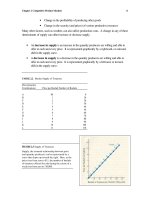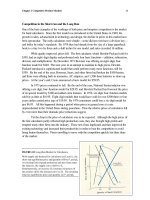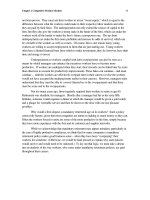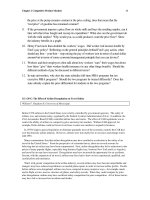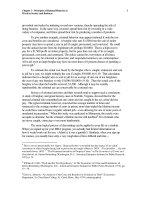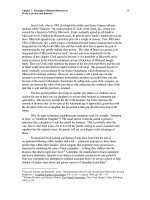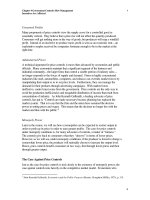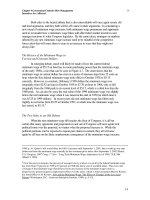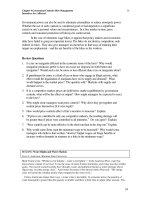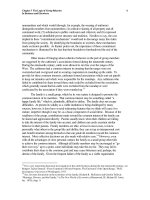Tài liệu Microeconomics for MBAs 10 docx
Bạn đang xem bản rút gọn của tài liệu. Xem và tải ngay bản đầy đủ của tài liệu tại đây (75.19 KB, 10 trang )
Chapter 3 Principles of Rational Behavior at
Work in Society and Business
8
proverbial one basket by initiating several new ventures, thereby spreading the risk of
doing business. In the same way, investors spread their risk by investing in a wide
variety of companies, and firms spread their risk by producing a number of products.
To give another example, criminal behavior may appear irrational if only the raw
costs and benefits are considered. A burglar who nets $1,500 from the sale of stolen
property may have to spend a year in jail if caught, prosecuted, and convicted. He could
lose the annual income from his legitimate job, perhaps $10,000. That is a high cost to
pay for a $1,500 profit on stolen property, but he pays that cost only if he is caught,
prosecuted, convicted, and sentenced. The police cannot be everywhere at all times;
prosecutors may be reluctant to prosecute; and suspended sentences are commonplace.
All in all, even an inept burglar may have no more than a 10 percent chance of spending a
year in jail.
4
To estimate the actual cost faced by the burglar who is caught, sentenced, and sent
to jail for a year, we might multiply the cost if caught, $10,000, by 0.10. That calculation
indicates that to a burglar who is sent to jail for an average of one out of ten burglaries,
the cost of any one burglary is only $1,000 ($10,000 x 0.10). Thus the actual cost of the
burglary is less than the benefits received, $1,500. Although it may be morally
reprehensible, the criminal act can conceivably be a rational one.
Surveys of criminal activities and their rewards tend to support such a conclusion.
A study of burglary and grand larceny cases in Norfolk, Virginia, showed that for the
unusual criminal who committed just one crime and was caught in the act, crime did not
pay. The typical criminal, however, convicted the average number of times and
sentenced to the average number of years in prison, more than tripled the lifetime income
he could have earned from a regular salaried job—even allowing for one or more years of
unsalaried incarceration.
5
When this study was replicated in Minnesota, the results were
not quite as dramatic, but the criminal’s lifetime income still doubled.
6
For criminals who
are never caught, crime pays even more handsomely.
The same logical process of discounting can be applied to your life as a student.
When you signed up for your MBA program, you actually had limited information on
how it would work out for you. (Admit it, it was a gamble!) Similarly, when you sign up
for courses, you usually have only a very rough idea of how difficult and time --
4
This is not an unreasonably low figure. Gregory Krohm “concluded that the chance of an ‘adult’
(seventeen or older) burglar being sent to prison for any single offense is .0024. . . For juveniles. . . the risk
was much lower, .0015.” “The Pecuniary Incentives of Property Crime,” in The Economics of Crime and
Punishment, ed. Simon Rottenberg (Washington, D.C.: American Enterprise Institute for Public Research,
1973), p. 33.
5
William E. Cobb, “Theft and the Two Hypotheses,” in The Economics of Crime and Punishment, ed.
Simon Rottenberg (Washington, D.C.: American Enterprise Institute for Public Policy Research, 1973), pp.
19 -- 30.
6
David L. Johnson, “An Analysis of the Costs and Benefits for Criminals in Theft” (Economics
Department, St. Cloud State College, St. Cloud, Minn., May 1974), mimeographed.
Chapter 3 Principles of Rational Behavior at
Work in Society and Business
9
consuming they will be, and what benefits you will receive from them. In other words,
you are rarely certain of their costs and benefits. To make your decision, you will have to
discount the raw costs and benefits by the probability of their being realized. Risks are
pervasive in human experience, and rational behavior takes those risks into account.
What Rational Behavior Does Not Mean
The concept of rational behavior often proves bothersome to the noneconomist. Most of
the difficulties surrounding this concept arise from a misunderstanding of what rationality
means. Common objections include the following:
1. People do many things that do not work out to their benefit. A driver speeds
and ends up in the hospital. A student cheats, gets caught, and is expelled
from school. Many other examples can be cited. To say that people behave
rationally does not mean that they never make mistakes. We can calculate our
options with some probability, but we do not have perfect knowledge, nor can
we fully control the future. Chances are that we will make a mistake at some
point, but as individuals, we base our choices on what we expect to happen,
not on what does happen. We speed because we expect not to crash, and we
cheat because we expect not to be caught. Both can be rational behaviors.
2. Rational behavior implies that a person is totally self -- centered, doing only
things that are of direct personal benefit. Rational behavior need not be
selfish. Altruism can be rational; a person can want to be of service to others,
just as he can want to own a new car. Most of us get pleasure from seeing
others happy—and particularly when their happiness is the result of our
actions. Altruism may not always spring from rational cost-benefit
calculations; however, it is not always inconsistent with economic rationality.
Self -- interest, moreover, does not necessarily stop at the individual. For
many actions, “self” includes members of one’s family or friends. When a
father spends a weekend building a tree house for his children, economists say
that he has been engaged in self -- interested behavior.
3. People’s behavior is subject to psychological quirks, hang -- ups, habits and
impulses. Surely such behavior cannot be considered rational. Human
actions are governed by the constraints of our physical and mental makeup.
Like our intelligence, our inclination toward aberrant or impulsive behavior is
one of those constraints. It makes our decision-making less precise and
contributes to our mistakes, but it does not prevent our acting rationally.
Moreover, what looks like impulsive or habitual behavior may actually be the
product of some prior rational choice. The human mind can handle only so
much information and make only so many decisions in one day.
Consequently, we may attempt to economize on decision making by reducing
some behaviors to habit. Smoking may appear to be totally impulsive, and the
physical addition that accompanies it may indeed restrict the smoker’s range
of choices. Why might a person pull a cigarette from the pack “without
Chapter 3 Principles of Rational Behavior at
Work in Society and Business
10
thinking”? Perhaps because she has reasoned earlier that contemplating the
pros and cons of smoking each and every time she things of cigarettes is too
costly. By allowing smoking to become more or less automatic, the smoker
probably increases the number of cigarettes she smokes daily, but she sees the
tedium of having to make the decision each and every time she smokes.
4. Rational behavior implies that people know what they want, that they know
which alternatives are available, and that they know how to act on that
information. People cannot assimilate all the information they need to make
rational choices, however. People do lack information, and they could make
better choices if information were easier to obtain. However, rational
behavior does not require perfect information. People will make choices on
the basis of the information they have or can rationally acquire. If they have
less than perfect information, they may make mistakes in their choices. The
success or failure of their choices must be judged within those constraints.
5. People do not necessarily maximize their satisfaction. For instance, many
people do not perform to the limit of their abilities. Satisfaction is a question
of personal taste. To some individuals, lounging around is an economic good;
by consuming it, they increase their welfare. Criticism of such is tinged with
normative value judgments. An observer who equates rational behavior with
what he or she considers good will have no trouble demonstrating that such
behavior is irrational. Irrational behavior is behavior that is inconsistent or
clearly not in the individual’s best interests and that the individual recognizes
as such at the time of the behavior.
6. But to the economist, the values of the actor, not the observer or the social
critic, determine the rationality of an act. Harold, not Jennifer or Max,
determines the rationality of Harold’s behavior.
Disincentives in Poverty Relief
Our discussion of rational behavior can be used to understand one of the biggest policy
issues of our time, welfare reform. We can do this by assuming that welfare recipients
are tolerably rational.
So much of the public discussions about welfare programs, especially cuts in
them, assumes that since Congress has the authority to change the programs, it can alter
the programs any way it wishes without creating problems. However, as we can easily
see, Congress is in something of an economic, if not political, bind on welfare relief,
given how incentives change when the program is adjusted. The basic problem is that the
practice of scaling down welfare benefits as earned income rises creates an implicit
marginal tax on additional earned income that discourages the poor from working. Why
not lower the implicit marginal tax rate?
Figure 3.3 gives the answer. The 45 -- degree line that extends out from the origin
indicates points of equal distance from each axis—that is, points at which spendable
Chapter 3 Principles of Rational Behavior at
Work in Society and Business
11
income equals earned income. At point y, for example, a poor person earns and can
spend $5,000 annually. At points above the line, spendable income exceeds earned
income. For instance, at point x, a poor person earns $5,000 annually and can spend
$7,500. He receives a subsidy equal to y – x, or $2,500.
FIGURE 3.3 Policy Tradeoffs of a Negative
Income Tax
With a guaranteed income of SI
1
($5,000) and a
break -- even earned income level of EI
1
($10,000),
the implicit marginal tax rate on the poor is 50
percent. If policymakers attempt to reduce the
implicit tax rate by raising the break -- even income
level, however, the government’s poverty relief
budget will rise by the shaded area SI
1
ab. A higher
explicit tax burden will fall on a smaller group of
taxpaying workers.
Suppose the government establishes a negative income tax with a guaranteed annual
income level of $5,000, or SI
1
. The break -- even earned income level is $10,000, or EI
1
.
A person who earns nothing will receive a subsidy of $5,000 a year. As his earned
income rises the subsidy will decline, until it reaches zero at $10,000. Curve SI
1
shows
the spendable income of people in this program at various earned income levels. They
lose $500 in subsidies for every $1,000 of additional earned income. That is, they face an
implicit marginal tax rate of 50 percent.
If policy markers want to reduce the implicit marginal tax rate on an earned income of
$10,000 to less than 50 percent, they must either reduce the guaranteed spendable income
level or raise the break -- even earned income level. If they raise the break -- even earned
income level—to $15,000, or EI
2,
for example—curve SI
1
a will shift to SI
1
b. But then
more people—all those with earned incomes up to EI
2
—will receive benefits. Moreover,
all the people covered originally will receive larger subsidies. A person with an income
of $5,000 would receive $8,000 instead of $7,000 in spendable income (point z instead of
point x), for example. The total increase in the government’s poverty relief expenditures
would equal the shaded area in the figure bounded by SI
1
ab.
The increase in expenditures would place a greater tax burden on taxpaying workers.
Yet because more workers would be covered by the negative income tax, fewer people
Chapter 3 Principles of Rational Behavior at
Work in Society and Business
12
would share the increased tax burden. Thus the explicit marginal tax rate on high --
income workers rises—lowering their incentive to work and earn additional income.
If the government reduces the guaranteed income level, say from SI
1
to SI
0,
a different
problem will result. On the new curve SI
0
a, the poor will receive less government aid at
each earned income level. They may have more incentive to work under such an
arrangement, but will they have enough to live on?
Policymakers, then, face difficult tradeoffs between the goal of helping the poor and
the goal of minimizing the disincentive to work. To provide adequate aid, they may have
to raise the breakeven income level high enough that people who are not strictly poor
benefit. Yet to reduce aid to people who are not truly poor, they would have to lower the
break -- even income level—thus increasing the implicit tax rate on the poor. To keep
the implicit marginal tax rate down, they could lower the guaranteed income level—
decreasing the benefits that go to the truly poor.
Our graphic analysis suggests that there may be economic as well as altruistic
limits to the government’s ability to transfer income from the rich to the poor. As more
and more income is allocated to the poor, either the guaranteed income or break -- even
income level must go up. If only the guaranteed income level is raised, the implicit
marginal tax rate facing the poor increases. If that problem is avoided by raising the
break -- even income level, poverty relief will cover more people, and the taxes paid by
the remaining workers will go up. Increased aid to the poor thus should have three
consequences. A higher explicit tax burden will fall on fewer taxpayers. Because of this
burden, higher -- income groups will have less incentive to work, and lower -- income
groups, because of the higher implicit tax rate, will also be less inclined to work.
MANAGER’S CORNER: The Last-Period Problem
Much of this chapter has been concerned with how people behave rationally. Here, we
introduce “opportunistic behavior” as a form of rational behavior that people in business
will want to protect themselves from. We suggest ways different parties to business deals
can take advantage of other parties and how managers can structure their organizational
and pay policies to minimize what we call “opportunistic behavior.” More specifically,
this section is concerned with how an announced end to a business relationship can
inspire opportunistic behavior. Its goal is, however, constructive, structuring business
deals – and the embedded incentives -- in order to maximize the durability and
profitability of the deals. To do that, business relationships must be ongoing, or have no
fixed end, to the extent possible. Having a fixed termination date can encourage
opportunistic behavior, which can reduce firm revenues and profits. That is to say, a
reputation for continuing in business has economic value, which explains why managers
work hard to create such a reputation.
